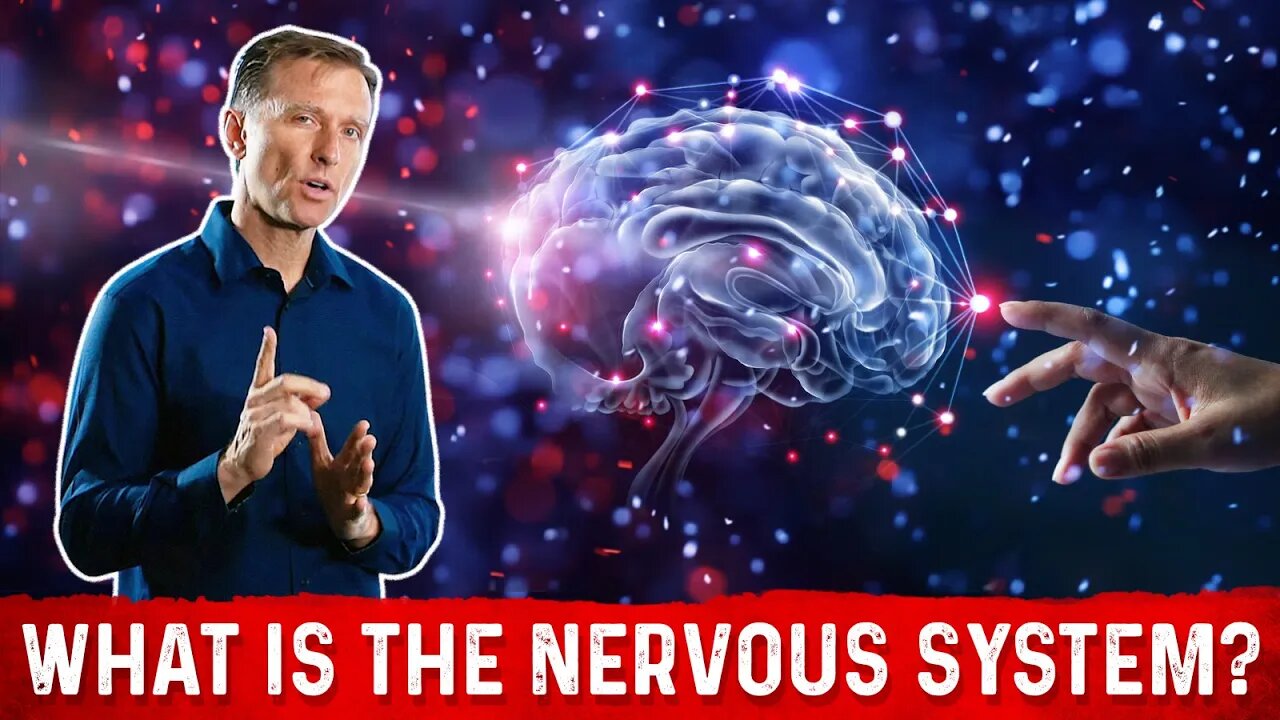Premium Only Content

What is the Nervous System? Explained By Dr. Berg
What is the Nervous System? Watch this video to find out..
The Nervous System is the part of a body that coordinates the voluntary (conscious) and involuntary (unconscious) actions of the body and sends signals between different parts of the body. It consists of two main parts, the central nervous system (CNS -- the brain and spinal cord) and the peripheral nervous system (PNS -- everything else apart from the brain and spinal cord).
Central Nervous System (CNS)
CNS is the part of the nervous system that integrates the information that it receives from the environment, and coordinates the activity of, to all parts of the body. It consists of the brain and the spinal cord.
Peripheral Nervous System (PNS)
PNS is the part of the nervous system consisting of the nerves outside of the brain and spinal cord. The main function of the PNS is to connect the central nervous system (CNS) to the limbs and organs, essentially serving as a communication relay going back and forth between the brain and the extremities. The PNS consists of 2 parts: the somatic nervous system (controlling muscle) and the autonomic nervous system (controlling gland and organs).
Somatic Nervous System (SNS)
This part of the PNS controls voluntary (conscious) control of body movements via muscles and skin.
Autonomic Nervous System (ANS)
The ANS is the part of the peripheral nervous system (outside the brain and spinal cord) that acts as a control system, functioning mostly below the level of consciousness (involuntary or automatic), and controls visceral (organ and gland) functions. The ANS innervates every organ and gland in your body.
The ANS affects heart rate, digestion, respiration rate, salivation, perspiration, the diameter of the pupils, urination, and sexual arousal.
The ANS maintains the homeostasis of the body.
Homeostasis is the adaptation of the internal body functions to the outside physical environment.
There are 3 parts: Sympathetic system is located at T1-T12 and inside the adrenal gland (adrenal medulla). The Parasympathetic system is located at C1 and in the sacrum area. The Enteric
(digestive) system is located in the abdomen.
Dr. Eric Berg DC Bio:
Dr. Berg, age 57, is a chiropractor who specializes in Healthy Ketosis & Intermittent Fasting. He is the author of the best-selling book The Healthy Keto Plan, and is the Director of Dr. Berg Nutritionals. He no longer practices, but focuses on health education through social media.
Follow Me On Social Media:
Facebook: https://bit.ly/FB-DrBerg
Instagram: https://bit.ly/IG-DrBerg
Anchor: https://bit.ly/Anchor-DrBerg
TikTok: https://bit.ly/TikTok-DrBerg
Send a Message to his team: https://m.me/DrEricBerg
ABOUT DR. BERG: https://www.drberg.com/dr-eric-berg/bio
Disclaimer:
Dr. Eric Berg received his Doctor of Chiropractic degree from Palmer College of Chiropractic in 1988. His use of “doctor” or “Dr.” in relation to himself solely refers to that degree. Dr. Berg is a licensed chiropractor in Virginia, California, and Louisiana, but he no longer practices chiropractic in any state and does not see patients so he can focus on educating people as a full time activity, yet he maintains an active license. This video is for general informational purposes only. It should not be used to self-diagnose and it is not a substitute for a medical exam, cure, treatment, diagnosis, and prescription or recommendation. It does not create a doctor-patient relationship between Dr. Berg and you. You should not make any change in your health regimen or diet before first consulting a physician and obtaining a medical exam, diagnosis, and recommendation. Always seek the advice of a physician or other qualified health provider with any questions you may have regarding a medical condition.
#keto #ketodiet #weightloss #ketosis
-
 10:49
10:49
Dr. Eric Berg
10 days agoThe #1 Most Dangerous Carb in the World
4.83K13 -
 LIVE
LIVE
PNW_Guerrilla
2 hours agoHalo CE
180 watching -
 1:01:11
1:01:11
Donald Trump Jr.
7 hours agoThe China Matrix with Journalist Lee Smith | TRIGGERED Ep.291
79.4K70 -
 LIVE
LIVE
XDDX_HiTower
50 minutes agoARC RAIDERS, FIRST DROP IN
44 watching -
 59:22
59:22
BonginoReport
4 hours agoWH Trolls Dems After Government Reopens - Nightly Scroll w/ Hayley Caronia (Ep.177)
54.5K37 -
 LIVE
LIVE
Spartan
4 hours agoFinishing Nine Sols, Another game after. Some College Halo Matches later on as well
51 watching -
 LIVE
LIVE
JDubGameN
1 hour agoI'm a raider | Road to LootFest 2026 | DubNation LIVE
38 watching -
 LIVE
LIVE
Mally_Mouse
3 days ago🎮 Throwback Thursday! Let's Play: Stardew Valley pt. 32
100 watching -
 LIVE
LIVE
Cewpins
1 hour agoChill Sesh🔥high dude🍃420💨!MJ
30 watching -
 0:09
0:09
Tundra Tactical
9 hours ago $2.54 earned🛑LIVE AT 6PM!! Guns And Games : Congress Calls For NFA Delete?? First Look Glock "V" and BF6 Later
12.8K2